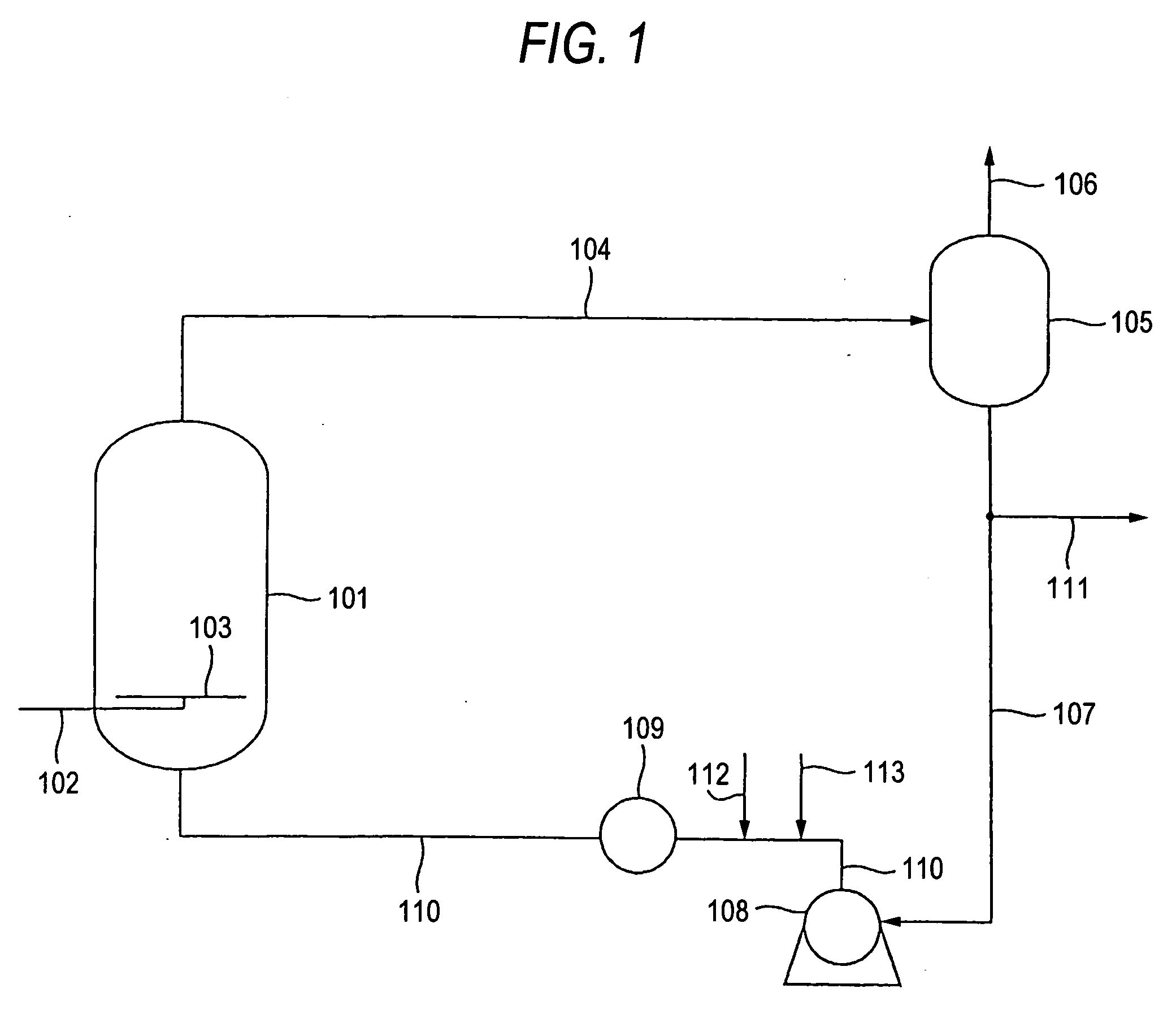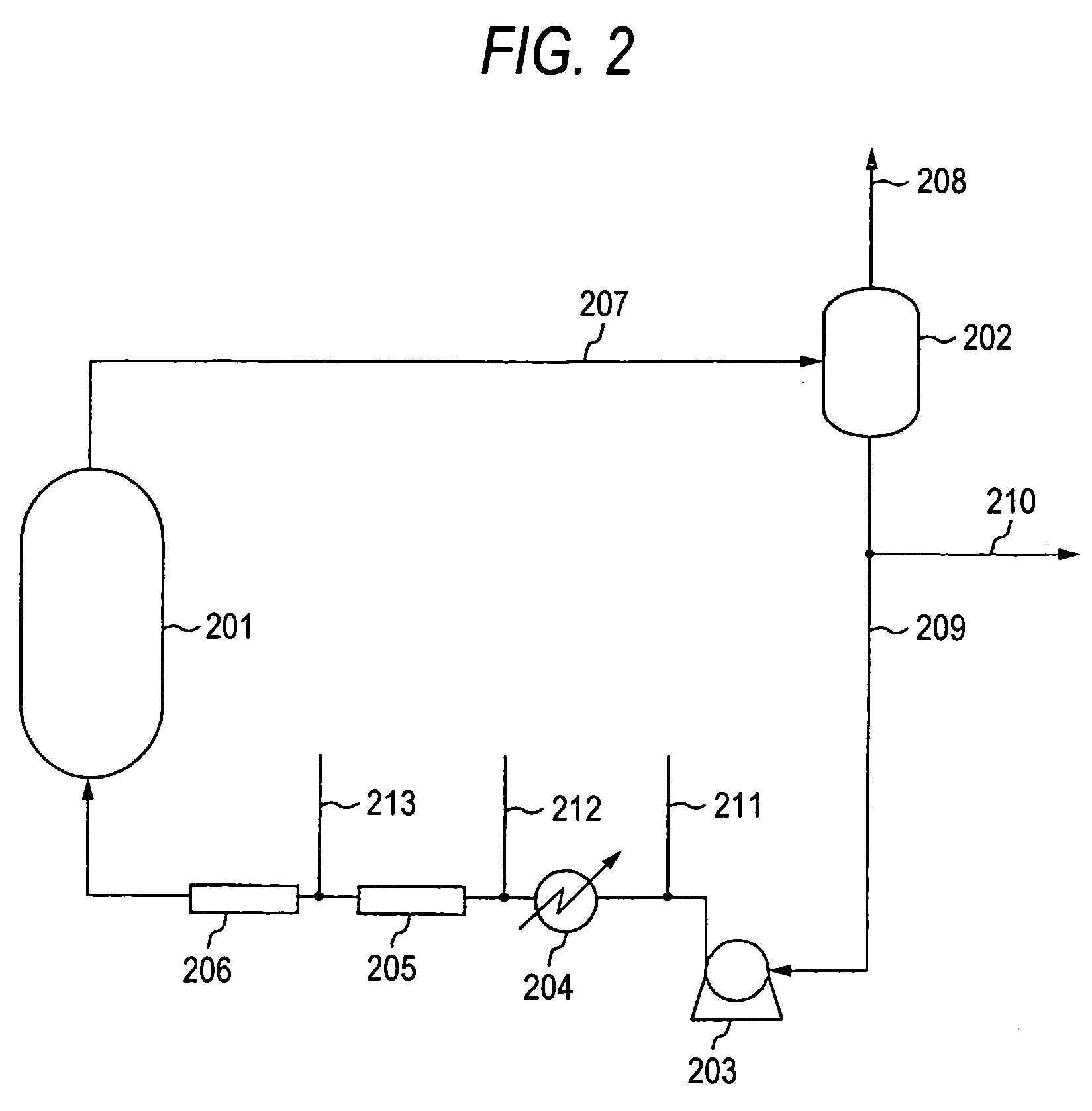Process for producing diacetoxybutene
- Summary
- Abstract
- Description
- Claims
- Application Information
AI Technical Summary
Benefits of technology
Problems solved by technology
Method used
Image
Examples
example 1
[0060] According to the flow sheet shown in FIG. 1, diacetoxybutene was produced from butadiene and acetic acid. A 5 wt % Pd-1.5 wt % Te / SiO2 catalyst prepared by allowing silica to support palladium and tellurium was packed into a reactor so as to form a fixed bed. A circulating liquid containing freshly supplied butadiene and acetic acid was fed to a lower part of the reactor at 77° C. and 6 MPa, and air was fed through a sparger having a hole diameter of 3 mm at a flow rate of 20 m / sec so as to form fine bubbles. The amounts of the butadiene and acetic acid freshly fed were 0.223 kg / hr and 3.235 kg / hr, respectively, per kg of the catalyst. The amount of the air fed was 0.454 kg / hr per kg of the catalyst, and the amount of the circulating flow withdrawn from the gas / liquid separator and introduced into the reactor was 14.306 kg / hr per kg of the catalyst. The amount of the butadiene contained in this circulating flow and introduced into the reactor was 0.055 kg / hr per kg of the cat...
example 2
[0061] A reaction for yielding diacetoxybutene from butadiene and acetic acid was conducted in completely the same manner as in Example 1, except that oxygen-enriched air having an oxygen concentration of 25.0 mol % was used as an oxygen-containing gas. The rate of reaction of the butadiene was 0.213 kg / hr per kg of the catalyst.
example 3
[0063] According to the flow sheet shown in FIG. 2, diacetoxybutene was produced from butadiene and acetic acid. A 5 wt % Pd-1.5 wt % Te / SiO2 catalyst prepared by allowing silica to support palladium and tellurium was packed into a reactor so as to form a fixed bed. A static mixer was employed as each of the former and latter mixing devices disposed in the circulating piping. Air was used as an oxygen-containing gas. The amount of the reaction liquid fed to a lower part of the reactor through the circulating piping was 14.306 kg / hr per kg of the catalyst, and the amounts of the acetic acid, air, and butadiene mixed with the reaction liquid were 3.235 kg / hr, 0.454 kg / hr, and 0.223 kg / hr, respectively, per kg of the catalyst. The amount of the butadiene contained in the reaction liquid and introduced into the reactor was 0.055 kg / hr per kg of the catalyst. The gas / liquid mixed phase flow was fed through the circulating piping to the reactor with sixteen circular nozzles at a flow rate...
PUM
| Property | Measurement | Unit |
|---|---|---|
| Length | aaaaa | aaaaa |
| Density | aaaaa | aaaaa |
| Area | aaaaa | aaaaa |
Abstract
Description
Claims
Application Information
 Login to View More
Login to View More - R&D Engineer
- R&D Manager
- IP Professional
- Industry Leading Data Capabilities
- Powerful AI technology
- Patent DNA Extraction
Browse by: Latest US Patents, China's latest patents, Technical Efficacy Thesaurus, Application Domain, Technology Topic, Popular Technical Reports.
© 2024 PatSnap. All rights reserved.Legal|Privacy policy|Modern Slavery Act Transparency Statement|Sitemap|About US| Contact US: help@patsnap.com










